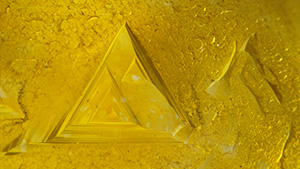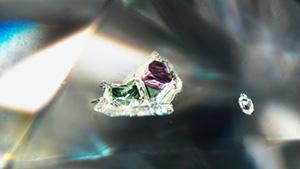

Yubing Chen, Jun Shu, Yanling Wang, and Qishen Zhou, August 4, 2023
Various inclusions are observed in a batch of aquamarine samples from Xinjiang, China.
Read More
Nathan Renfro, August 4, 2023
Bluish green and white spheres create a beautiful inclusion scene in quartz from Larimer County, Colorado.
Read More
Mei Yan Lai and Matthew Hardman, August 4, 2023
A feather inclusion with iridescence caused by thin-film interference in diamond resembles an insect wing.
Read More
Nicole Ahline, August 4, 2023
Isolated nitrogen confined to the outer surface of a 0.98 ct diamond causes “yellow skin.”
Read More
Tejas Jhaveri and Sally Eaton-Magaña, August 4, 2023
An iridescent feather inclusion in natural diamond bears resemblance to Rainbow Mountain in Peru.
Read More
Michaela Damba, August 4, 2023
A dark crystal and a stress cleavage crack resemble a quarter note in a diamond.
Read More
Christopher Vendrell, August 4, 2023
A combination of pyrope garnet and diopside inclusions is reminiscent of a snail in a near-colorless diamond.
Read More
E. Billie Hughes, August 4, 2023
An intriguing metallic inclusion is observed in a faceted garnet.
Read More
Jeffrey Hernandez, August 4, 2023
A hexagonal platelet of graphite is discovered in a pink sapphire from Sri Lanka.
Read More
Charuwan Khowpong, August 4, 2023
Fiber-optic light creates a night sky scene in a yellow sapphire from Madagascar.
Read Morepast gems & gemology issues







